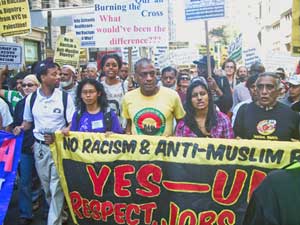Thousands show solidarity with New York’s Muslim community
By
John Catalinotto
New York
Published Sep 11, 2010 11:56 PM
In a city that is home to more nationalities than any other in the world, all
seemed represented in the crowd of thousands who came to demonstrate in the
City Hall area on Sept. 11. They were there to express solidarity with the
Muslim community in the struggle over the building of an Islamic Community
Center near the World Trade Center site.
|
New York, Sept. 11.
WW photo: John Catalinotto
|
Answering the call of the Emergency Mobilization Against Racism &
Anti-Muslim Bigotry, people from Boston, Washington and in between joined
thousands of New Yorkers in a display of the strength of the anti-racist
movement that embraced young and old, people of all the colors of the city and
region, gay and straight. The demonstrators exuded a spirit of unity and
cooperation by chanting, marching and then chipping in their labor to clean up
at the end of the day’s action.
International Action Center co-coordinator Sara Flounders, one of the rally
chairs, told Workers World that “10,000 people joined today, coming from
dozens of communities in the city. They represented neighborhood organizations,
religious groups of all kinds, political and anti-war groups and human rights
groups. Many workers wore their union caps or tee shirts.”
Just naming Flounders’ co-chairs gives a modest idea of the breadth of
the rally’s support: They were Sayel Kayed of American Muslims for
Palestine; Dr. Asha A. Samad-Matias of the Safrad Somali Association and the
Muslim Women’s Coalition; Lucy Pagoda of the May 1st Coalition for Worker
and Immigrant Rights; and Amadi Ajamu of the December 12th Movement. Another 48
diverse speakers and cultural groups gave greetings or performances.
At 3 p.m. the pro-unity gathering far outnumbered an anti-Muslim protest
organized by the much-publicized Tea Party. In addition, hundreds of
anti-racist protesters, many with home-made signs, were surrounding the Tea
Party and showing their opposition to its message of hatred. Just two weeks
earlier the anti-Muslim crowd had been getting the main media attention and was
pouring money into advertising for their action.
In late August the IAC had put out an initial call for a counter-rally; soon
more than 100 organizations had come together and formed the Emergency
Mobilization. With little time to organize and less money, the ad hoc group was
still able to get out 100,000 pieces of literature in the two weeks before the
rally.
“We had to organize on a shoestring budget,” said Flounders,
“putting the bills for leaflets and posters and signs on people’s
credit cards and hoping we could pay for the demonstration. It was worth it. We
showed that a broad section of the city won’t let the racists invade and
dominate 9/11.”
The message from the nearly 50 speakers on the stage of the Emergency
Mobilization action was a strong one of solidarity and unity — solidarity
with the Muslim community in the United States and unity of all the forces who
came that day in the struggle against all forms of racism and scapegoating,
against U.S. wars abroad and for jobs, education and social benefits at
home.
One of those speakers, Larry Holmes of the Bail Out the People Movement, told
Workers World, “We brought out the real New York City — a city of
workers and peoples of color from all around the world. This mobilization
started because we were forced to defend our Muslim sisters and brothers. It
will continue because we have to open up the struggle against war, against
racism, and for jobs, education and health care. There is much more to fight
for and now we all know who we can count on.”
Articles copyright 1995-2012 Workers World.
Verbatim copying and distribution of this entire article is permitted in any medium without royalty provided this notice is preserved.
Workers World, 55 W. 17 St., NY, NY 10011
Email:
ww@workers.org
Subscribe
wwnews-subscribe@workersworld.net
Support independent news
DONATE


